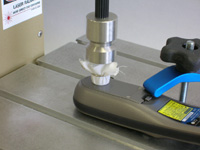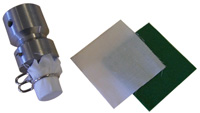Crockmeter Attachment
Taber Linear Abraser (Abrader) with Crockmeter Attachment
 The Crockmeter Attachment is used to convert the Taber Linear Abraser into a crockmeter. Originally used to determine color fastness to crocking, the crockmeter is a standard instrument of the AATCC (American Association of Textile Chemists and Colorists). Most often referenced in textile specifications, crocking is the term used to describe the transfer of color from the surface of a colored fabric to an adjacent area of the same fabric or to another surface principally by rubbing action.
The Crockmeter Attachment is used to convert the Taber Linear Abraser into a crockmeter. Originally used to determine color fastness to crocking, the crockmeter is a standard instrument of the AATCC (American Association of Textile Chemists and Colorists). Most often referenced in textile specifications, crocking is the term used to describe the transfer of color from the surface of a colored fabric to an adjacent area of the same fabric or to another surface principally by rubbing action.
The test piece is secured under the path of a 16mm diameter acrylic rubbing finger. A 50mm square crocking cloth is affixed to the rubbing finger, and held in place using a spring clip. Weighted at a force of 9N, the finger traverses a 100mm long straight path where each back and forth movement of the finger is referred to as a “double-rub”. After rubbing specimens for a specific number of double rubs, the staining of the crocking cloth is assessed by comparing the degree of ‘dirtiness’ with an approved grey scale rating. You may develop color scales of your own or use color scales already established by published test standards such as ASTM D6279: Rub Abrasion Mar Resistance of High Gloss Coatings, or AATCC Test Method 8: Colorfastness to Crocking: AATCC Crockmeter Method. Performance is normally measured by 1 – 5 rating scale, with 5 representing excellent and 1 being poor crock resistance.
 Because of its ease of use, crockmeters have been employed to conduct wet / dry scuffing tests, smudge resistance tests, rubbing tests, abrasion tests, and to emulate the physical contact made by a finger tip on flat specimens. For all of these tests, the attachment is moved back and forth over the specimen surface to elicit a change in the appearance of the sample. Modifications to how the test is performed include moving a weighted felt pad across a surface or using abrasive paper to mimic the effects of random scratching.
Because of its ease of use, crockmeters have been employed to conduct wet / dry scuffing tests, smudge resistance tests, rubbing tests, abrasion tests, and to emulate the physical contact made by a finger tip on flat specimens. For all of these tests, the attachment is moved back and forth over the specimen surface to elicit a change in the appearance of the sample. Modifications to how the test is performed include moving a weighted felt pad across a surface or using abrasive paper to mimic the effects of random scratching.


